Abstract
In many developing regions, recruitment still relies heavily on traditional methods that often ignore the importance of aligning a candidate’s personality with the job role. This mismatch can lead to poor performance, dissatisfaction, and high turnover. To address this, the study presents a personality-aware recommendation system that combines the Myers–Briggs Type Indicator (MBTI) with machine learning to support smarter hiring decisions. The system is tailored for the South Asian job market and includes two main components: a web-based MBTI assessment for applicants and a dashboard for HR professionals powered by a XGBoost classifier. This model was trained on a dataset correlating applicant profiles and the flagged preferences of MBTI with the job. Experience and the number of skills, education level, and encoded MBTI types were the key features, and the SMOTE method was employed to balance the dataset. The model attained an accuracy of 74.30%, having balanced precision and recall measures. It was also discriminative, the ROC AUC was 0.84, and the precision–recall AUC was 0.85. One example of utilizing the Software Developer position in real life demonstrated the success of the system to filter and rank candidates at the same time according to both technical and personality-specific criteria. Overall, this study emphasizes the worth of combining insights from psychological profiling with machine learning in order to develop a more holistically, fair, and efficient hiring process.
1. Introduction
Recruitment is not merely a procedural function within human resource management; it is a strategic determinant of organizational success. The individuals an organization hires shape its culture, influence innovation, and directly impact productivity and long-term sustainability [1]. As global markets become more competitive and dynamic, the demand for not just skilled but well-aligned employees has intensified. However, in many developing countries, recruitment practices remain largely conventional, relying heavily on academic qualifications, prior experience, and basic technical assessments [2].
These traditional methods often overlook a critical dimension of hiring: the alignment between a candidate’s personality and the nature of the job. This oversight can lead to significant mismatches, where technically capable individuals struggle to thrive due to a poor psychological or cultural fit [3]. Such mismatches frequently result in job dissatisfaction, interpersonal conflict, low morale, and, ultimately, high employee turnover [4].
Employees placed in roles misaligned with their personality traits frequently experience disengagement, underperformance, and early attrition [5]. These outcomes not only disrupt team cohesion but also increase recruitment and training costs, thereby reducing overall organizational efficiency [6].
Towards that end, there is rising concern about the need to incorporate the notion of psychological profiling into recruitment systems in preconcerted efforts to address these particular circumstances. The Myers–Briggs Type indicator (MBTI) is one of many personality assessment tools; however, it is easy to adopt the framework, and it is used widely [7]. Based on the theory of psychological types by Carl Jung, MBTI contains 16 personality types cutting across the four dichotomies of Extraversion/Introversion, Sensing/Intuition, Thinking/Feeling, and Judging/Perceiving. Each one is an indication of a particular form of perception of the world, information processing, and interaction with others [8].
Although MBTI has been widely used in personal development, team building, and leadership training contexts, its official inclusion into recruitment systems and specifically the South Asian-level context has been quite limited [9]. Personality tests are commonly informal or secondary measures in South Asia, not part of the main determination process in job recruitment [10]. This leaves a gap in opportunities to improve the quality of personnel and achieve lower turnover rate by increasing the level of person–job fit [11,12].
New discoveries in artificial intelligence and machine learning have provided additional opportunities in automating and expanding personality-based recruitment. It has also been found that it is possible to accurately predict psychological indicators and occupational preferences through personality traits by the use of machine learning models; this prediction technique leads to better job–person matching [13]. Nevertheless, most of those systems are based on the concept of the Big Five personality and have been adjusted to Western labor markets [14,15]. There is limited research on how MBTI can be used in algorithmic recruitment systems, particularly in emerging economies [16].
This study helps to fill that gap with the creation of an intelligent but still MBTI-based candidate recommendation system specifically adjusted to the South Asian recruitment environment. The given platform will evaluate the personality types of candidates with the help of a standardized digital test and connect them to the appropriate work position, considering the compatibility of their personalities. In this way, this platform should be able to help HR professionals make more all-rounded, data-based hiring decisions, which would reflect both expertise and person–job fit.
Also, there is limited research on the ethical and cultural consequences of personality profiling in non-Western contexts, which poses a serious gap; this study tries to address this gap.
This study addresses these challenges by proposing an automated system that evaluates candidates’ MBTI profiles and matches them with job requirements. By introducing objective, data-driven criteria into the hiring process, the system aims to enhance recruitment efficiency, reduce turnover, and improve organizational performance, as follows:
- To make HR processes more efficient by introducing an automated system that handles personality assessments and evaluates how well candidates fit specific job roles.
- To save time in the recruitment process by replacing traditional, paper-based personality tests with a faster, fully digital solution that is easier to manage and scale.
- To build a two-part recruitment system that includes the following:
- ○
- A user-friendly platform for applicants, where they can take the MBTI personality test in a simple and accessible way.
- ○
- A web-based dashboard for HR professionals, where we introduced the ML (machine learning) model to analyze personality–job compatibility and candidate selection.
The scope of this paper is devoted to the development and automation of a recruiting system based on MBTI adapted to South Asia’s job market. The system consists essentially of two parts, the first one being a web interface where candidates can take standardized versions of the MBTI test and the second one being a dashboard where HR professionals can analyze the compatibility between personalities and job openings and receive candidate suggestions, as illustrated in Figure 1.
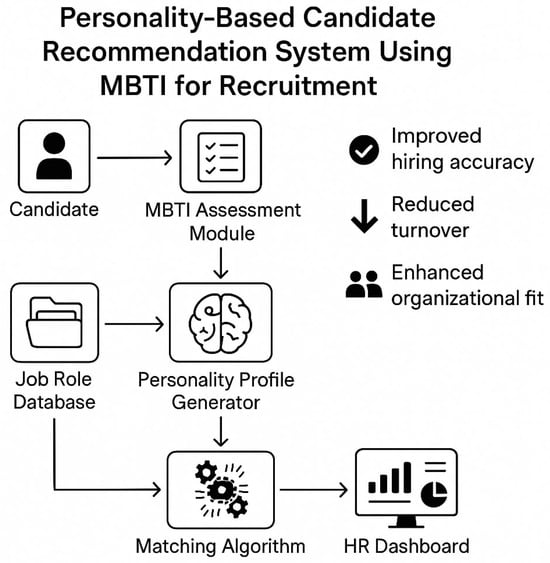
Figure 1.
Personality-based candidate recommendation system.
2. Literature Review
MBTI is a psychological theory based on the theory of psychological types developed by Carl Jung. It identifies 16 personality types in terms of four dichotomies, Extraversion and Introversion, Sensing and Intuition, Thinking and Feeling, and Judging and Perceiving [17]. Each pair represents different manners of perceiving the world, making decisions, and communicating with others. MBTI has also been popularly applied in personal growth/development, leadership training, and team building contexts based on its self-explanatory format and convenient applicability [18].
MBTI has been used in organizational psychology to interpret the behavior of employees and enhance communications and team building [19]. It does not yet determine the job performance of a person, but this is good because it determines the compatibility of both a person’s personality and a job instead, and this can determine an individual’s satisfaction levels, motivation, and retention in the job [20]. MBTI has experienced considerable acclaim in the business education sector and in individual growth [21], but it has also faced some criticism in the field of academic psychology. Such criticisms mainly emphasize the psychometric limitations of the assessment, which are in relation to its reliability and validity [22]. Critics contend that the forced dichotomous nature of the instrument (e.g., Introvert or Extravert) is an oversimplification of personality widely conceived to exist on a continuum [23,24].
The recruitment process has changed with the involvement of artificial intelligence (AI). Today, modern recruitment platforms take advantage of machine learning, natural language processing (NLP), and predictive analytics to automate resume screening, candidate fit determination, and decision-making. Many of these systems combine personality testing methods that improve the candidate–job fit [25].
Such AI-based recruiting instruments, though, are typically based on the Big Five model of personality, whose predictive validity has only been found to be moderate in terms of job performance, especially regarding the personality trait of conscientiousness. Companies like HireVue and Pymetrics process behavioral data and provide gamified tests to assess personality traits and prescribe applicants based on the results [26]. These systems have enhanced efficiency and objectivity, but they were created to suit Western labor markets; hence, they do not take full consideration of the cultural and contextual differences among countries in South Asia [27].
Use of MBTI in this study is not just based on factors pertaining to practice but also contextual factors. The structured typology provided by MBTI makes translating personality characteristics to job characterization simple, and, hence, it can be implemented into an algorithm [28]. Also, its general endorsement within the business world makes it more acceptable to users, especially in countries of South Aisa where MBTI is already informally applied in various HR departments [29].
MBTI’s emphasis on cognitive and interpersonal preferences correlates well with soft skills, which are gaining popularity in contemporary workplaces and include communication, flexibility, and collaboration [30]. Integrating MBTI into a computer-based recruitment application, this study intends to preserve the divide between the psychological theory and the hiring practice while providing a more integrated and human-centered response to candidate assessment [31].
Machine learning has seen recent advancements that allow recruitment systems to include psychological profiling, including the Myers–Briggs Type Indicator (MBTI). The XGBoost model is one of the algorithms that have demonstrated encouraging outcomes in forecasting personality traits based on candidate data, i.e., data that includes CVs and behavioral patterns [32].
Singh was able to apply Random Forest and XGBoost models to predict MBTI personality types based on textual data extracted from CVs, and this was due to the model extracting subtle linguistic information and matching it with psychological models [32]. Similarly, several machine learning methods were assessed in another study, among which Random Forest was used to predict personality based on a framework concerning the Big Five. The research attributed the strength of RF in processing various data types and minimizing recruitment bias [33].
This research complements the application of XGBoost to the recruitment process in platforms that seek to increase the level of decision-making using the area of psychology. Although recruitment using MBTI is emerging, blending RF models provides an easily scaled and understandable method to balance the characteristics of candidates and the necessities of an organization.
3. Methodology
Here, the methodology involved in producing the HR recommendation system is presented; this system seeks to predict whether job candidates successfully fit select positions in terms of their profiles and in terms of their of Myers–Briggs Type Indicator (MBTI) personality types. The system takes advantage of machine learning to make suitability predictions and can provide substantial model-based assessments.
3.1. System Objective
This system is aimed at supporting HR practitioners by suggesting the appropriate candidate for a particular job. The task is achieved by training a classification model that selects a binary label of suitability (1 to suggest that applicant–job fit is suitable and 0 otherwise) to every applicant–job pair. The system aligns the profile data of the applicants with the pre-set suitability of their MBTI type to different job positions.
3.2. Data Collection and Description
Two datasets were employed during this research to support the development and evaluation of the applicant recommendation system. The first dataset used in this study comprises 800 applicant records, each representing a unique candidate profile. The data were synthetically generated to simulate realistic recruitment scenarios while ensuring privacy and ethical compliance.
- Nature of the Dataset:Each record includes the following:
- ○
- Personal identifiers (name, email, contact);
- ○
- Job position applied for;
- ○
- Skill set (free-text list);
- ○
- Years of professional experience;
- ○
- Academic qualification;
- ○
- MBTI personality type;
- ○
- Soft skills;
- ○
- CV file path.
- Extent and Characteristics:Qualification Distribution:
- ○
- Bachelor’s: 208;
- ○
- High School: 207;
- ○
- PhD: 202;
- ○
- Master’s: 183.
Experience Range:- ○
- Minimum: 0 years;
- ○
- Maximum: 20 years;
- ○
- Mean: 10.33 years;
- ○
- Standard Deviation: 6.01 years.
MBTI Type Distribution:- ○
- Most common types: ENTP (72), ESTJ (65), ISTP (59);
- ○
- All 16 MBTI types are represented, ensuring diversity in personality profiles.
Job Title Distribution:- ○
- The most common roles were Project Manager (86), Software Developer (83), and Data Scientist (80);
- ○
- Other roles include Software Engineer, Social Media Manager, Marketing Specialist, and HR Manager.
This dataset was used to train and evaluate the recommendation system, ensuring balanced representation across qualifications, experience levels, personality types, and job roles.
The second dataset establishes mapping between various job titles and the corresponding MBTI personality types considered suitable for each role. This dataset functions as the ground truth for defining personality-based suitability criteria, thereby guiding the alignment of applicant profiles with job-specific psychological attributes.
3.2.1. Expert-Informed Personality–Job Role Mapping
To establish a valid and practical foundation for the personality-informed candidate recommendation framework, a qualitative, expert-driven methodology was employed to link specific job roles to relevant MBTI personality types. This approach was designed to incorporate industry insights and validate the theoretical underpinnings of the framework with real-world hiring practices.
3.2.2. Subject Matter Expert Consultation
The process began with the identification and recruitment of three HR professionals who possessed significant expertise in using the MBTI tool within a corporate recruitment context. These individuals were selected based on their proven experience in applying personality assessments to inform hiring decisions for a range of professional designations. We contacted Barqsol Technologies, HHHC Technologies, and Asteria Technologies. The consultation was conducted through a structured, collaborative process, serving as a form of expert elicitation. The objective was to leverage their professional judgment and empirical knowledge to map a set of predefined job roles to the most suitable MBTI personality types.
3.2.3. Mapping Process
The consultation followed a systematic procedure, as follows:
- Introduction of Job Roles: The HR professionals were presented with a comprehensive list of specific job designations relevant to modern industries, including Data Analyst, Digital Marketing Specialist, Social Media Marketing Specialist, Software Developer, HR Manager, and Business Developer.
- MBTI Framework Discussion: A brief overview of the 16 MBTI personality types was provided to ensure shared understanding of the framework’s dimensions (Extraversion/Introversion, Sensing/Intuition, Thinking/Feeling, and Judging/Perceiving) and their behavioral indicators.
- These professionals used the principles of psychological profiling and applied them together with their hands-on experience with recruitment to match MBTI types to employment opportunities. The criteria used included the following:
- ○
- Behavioral Traits and Role Demands: Experts took the behavioral requirements of each job position, including those of a leader, an analyst, a group member, or a flexible person, and compared them with MBTI personality traits. Experts matched MBTI traits with the cognitive demands and interpersonal dynamics of each role. For example, ISTJ types known for their reliability and attention to detail were mapped to roles like Software Engineer and Data Analyst, which require precision and structure.
- ○
- Performance Benchmarking: The personality traits of employees who performed highly in certain positions were analyzed by professionals and compared to those who performed at an average level. The given comparative analysis aided in determining the MBTI types that were always associated with success in the given roles.
- ○
- Cognitive and Interpersonal Fit: Cognitive and interpersonal preferences (e.g., Thinking vs. Feeling) were also considered in the mapping to guarantee compatibility with the team dynamics and organizational culture.
- ○
- Industry-Specific Situation: Since this study concerned a South Asian context, the focus of the experts was on the compatibility of the cultures, styles of communication, and hierarchical workplace settings. In the case of the ISFJ and ESFJ types, these types were preferred for HR activities because of their empathetic and organized characteristics, which fits the collectivist cultural requirements.
These criteria comply with some traditional practices in MBTI-based recruitment theories where job–person fit is established by matching psychological preferences with job attributes.
The outcome of this process is a qualitative, expert-validated mapping that provides a practical and informed basis for the candidate recommendation framework. The identified personality types are not intended to be exclusive criteria but rather a guide for identifying candidates with an innate predisposition for success and satisfaction in a particular role.
Table 1 summarizes the key mappings derived from this consultation.

Table 1.
Job title and MBTI mapping.
3.2.4. MBTI Determination Process
- ○
- Method Used: A standard MBTI questionnaire was administered digitally to each applicant. This was based on widely accepted MBTI inventories aligned with the original framework by Isabel Briggs Myers and Katharine Cook Briggs.
- ○
- Human vs. Automated: The MBTI classification was entirely automated through the digital questionnaire. No manual review or inference from CVs was performed to determine personality types.
- ○
- CV Role: CVs were used solely for evaluating technical qualifications, experience, and skills. They were not involved in personality profiling.
Each applicant completed this assessment voluntarily via the web-based interface before their profile was included in the dataset, as shown in Figure 2. This approach ensured that the MBTI classification was self-reported, based on validated psychological instruments, rather than inferred from textual data in CVs.
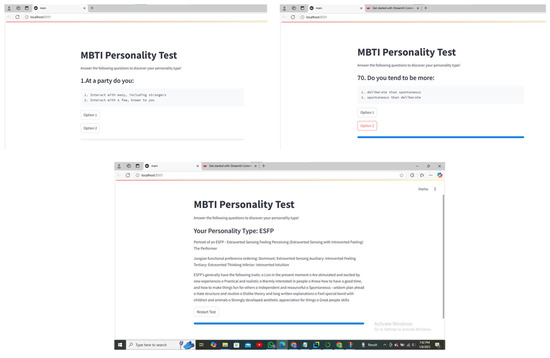
Figure 2.
Self-reported MBTI test.
3.2.5. Error Margins and Reliability
- ○
- Instrument Validity: The MBTI questionnaire used has been validated in prior studies and is widely adopted in organizational psychology. While MBTI has known limitations in psychometric robustness, its structured typology and widespread acceptance in business contexts made it suitable for our recruitment-focused application.
- ○
- Error Considerations: Since MBTI types were self-reported, the primary source of error would stem from response bias or misinterpretation of questions. To mitigate this, no inference from CVs was made, avoiding the risk of misclassification due to engineered or biased resume content.
We deliberately avoided the direct inference of MBTI types from CVs for the sake of necessity, as this inference would potentially be more imprecise. There is also a tendency for CVs to be written in a way that reflects positively on the applicant, and they can leave out or under-represent early characteristic features of their personalities, which are crucial for proper profiling. In spite of the existence of hybrid methodologies in the literature, in which both the content in a CV as well as the results of a questionnaire are studied, we decided to rely on a clinical version of the MBTI questionnaire with the absence of additional methodologies of cognition used. This was performed to ensure reliability and lessen bias in the classification of personality.
3.3. Machine Learning Model Selection
To establish a clear mapping between MBTI personality types and specific job roles, we used a supervised machine learning model. This predictive model was developed to move beyond static, manual mappings by learning to identify suitable MBTI types from job descriptions.
The model was trained on a labeled dataset of job descriptions, each tagged with its ideal MBTI type. We used an XGBoost classifier, which analyzed features from the job descriptions.
3.4. Data Preprocessing
The raw datasets underwent several preprocessing steps to prepare them for model training, as illustrated in Figure 3.
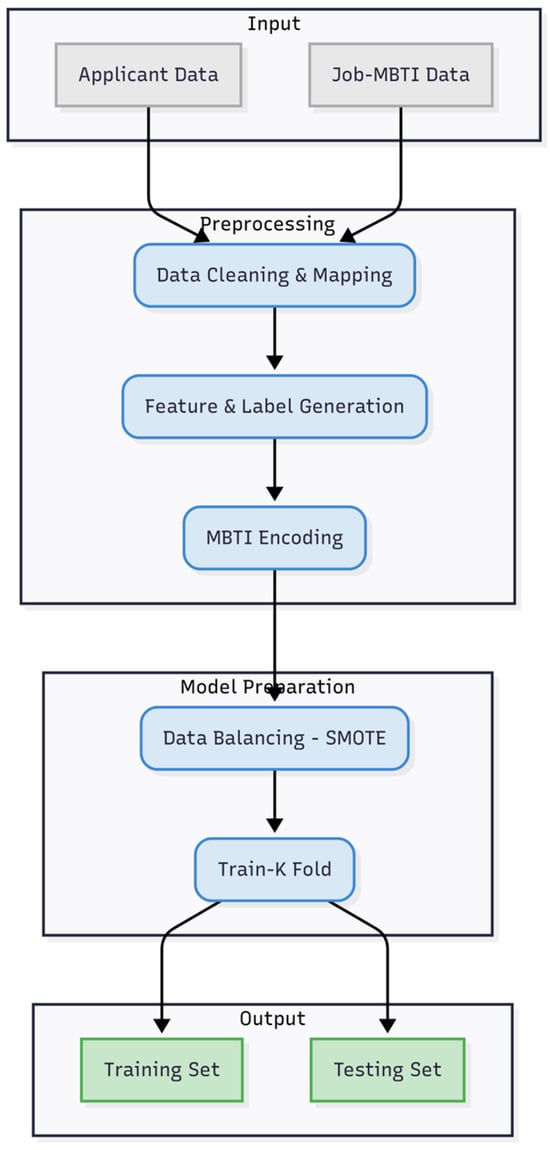
Figure 3.
Data preprocessing and model preparation.
- Column Standardization: Column names in Applicant_data.csv were standardized to Job_Title (from position) and MBTI_Type (from mbti_type) to ensure consistency across datasets.
- Job–MBTI Suitability Map Creation: The enhanced_job_mbti_dataset.csv was processed to create a job_mbti_map. This map is a dictionary (specifically, a defaultdict), where keys are Job_Titles and values are lists of MBTI_Types deemed suitable for that job. This mapping is crucial for generating the target variable for the suitability prediction model.
- Feature and Target Variable Generation: For each applicant in the Applicant_data.csv, a set of features (X) and a binary suitability label (y) were generated for every Job_Title present in the job_mbti_map.
- ○
- Features (X): The input features (X) utilized for training the suitability prediction model were systematically derived from the applicants’ profiles to ensure consistency and relevance. These features include experience, represented as a numerical value indicating the number of years of professional experience; in cases where non-numeric values were encountered, a default value of zero was assigned. The skill count feature captures the total number of distinct skills listed by the applicant, serving as a proxy for technical breadth. Two binary indicators—isphd and isms—were introduced to reflect the presence of advanced academic qualifications, with values set to 1 if the applicant’s qualification field contained the terms “PHD” or “MS,” and 0 otherwise. Lastly, the applicantmbti feature, denoting the applicant’s MBTI personality type, was encoded into a numerical format to facilitate its integration into the machine learning model. Collectively, these features form a structured representation of each applicant’s profile, enabling the model to make informed predictions regarding job suitability; details are mentioned in Figure 2.
- ○
- Target Variable (y): A binary label indicating suitability was assigned to the applicant’s type—1 if the applicant’s MBTI_Type was present in the suitable_mbti_list for a given Job_Title (from job_mbti_map), and 0 otherwise. This transformation resulted in a significantly expanded dataset for model training, with each row representing an applicant–job suitability instance.
- MBTI Encoding: The categorical MBTI_Type feature (both for applicants and for the target variable generation) was converted into numerical labels using sklearn.preprocessing.LabelEncoder.
- Data Balancing (SMOTE): Given that the “suitable” (1) class is typically a minority class compared to “not suitable” (0) combinations, the Synthetic Minority Over-sampling Technique (SMOTE) from the imblearn library was applied to the training data. This technique oversamples the minority class by creating synthetic samples, thereby addressing potential class imbalance and preventing the model from being biased towards the majority class.
- Train–Test Split: To ensure a robust and unbiased evaluation of the model’s performance, K-fold cross-validation was used. The preprocessed and balanced dataset was divided into k distinct, non-overlapping folds. The model was then trained and validated k times. In each iteration, 1 fold was designated as the testing set, while the remaining k − 1 folds were combined to form the training set. To mitigate class imbalance and ensure each fold was representative of the full dataset, stratified sampling was applied during the fold creation process. The final performance metrics were calculated by averaging the results across all k iterations, providing a more reliable measure of the model’s generalization capability.
3.5. Model Selection and Training
The predictive model using XGBoost to determine the suitability of an applicant was chosen because of its robustness, scalability, and aptitude in identifying complex and non-linear relationships in structured data. As a gradient boosting machine, XGBoost consists of a series of decision trees in an ensemble that aims to adjust the mistakes of the previous decision trees and, in so doing, increases the correctness of the predictive model. In order to maximize model performance, some of the most important hyperparameters were set, as follows: a parameter n_estimators = 100 dictated the amount of boosting rounds; max_depth = 3 served to control the depth level of each tree to avoid overfitting; and the parameter min_child_weight = 5 regulated the minimum weighted sum of instances required in a child node, influencing the number of branches in the trees. In an attempt to overcome class imbalance, the scale_pos_weight parameter was also set to the inverse ratio of class frequencies so that the minority classes were treated with fairness. Also, the random_state = 42 was defined to enable result reproducibility on training iterations. The model used to predict the suitability of applicants to different jobs was trained with the X_train feature set with the associated suitability label y_train that allowed it to learn some discriminative patterns, signifying applicant–job fit.
3.6. Model Evaluation
The trained model’s performance was rigorously evaluated using a suite of standard classification metrics and visualizations on the unseen X_test and y_test data.
- Overall Accuracy: measures the proportion of correctly classified instances out of the total.
- Confusion Matrix: a 2 × 2 matrix visualizing the performance of the binary classification model, showing True Positives (TPs), True Negatives (TNs), False Positives (FPs), and False Negatives (FNs). A heatmap visualization was used for clarity.
- Classification Report: The classification report serves as a comprehensive evaluation of the model’s performance by presenting detailed metrics for each class, namely, “Not Suitable” (0) and “Suitable” (1). It includes precision, which quantifies the proportion of correctly identified positive instances among all instances predicted as positive, thereby reflecting the model’s accuracy in positive classification. Recall measures the proportion of actual positive instances that were correctly identified by the model, indicating its effectiveness in capturing relevant cases. The F1-score, calculated as the harmonic mean of precision and recall, offers a balanced metric that accounts for both false positives and false negatives. Lastly, support denotes the number of actual occurrences of each class within the test dataset, providing context for the reliability of the metrics. Collectively, these measures enable a nuanced understanding of the model’s predictive capabilities across different outcome categories.
- Receiver Operating Characteristic (ROC) Curve and Area Under the Curve (AUC): The ROC curve plots the True Positive Rate (TPR) against the False Positive Rate (FPR) at various threshold settings. The AUC provides an aggregate measure of performance across all possible classification thresholds, indicating the model’s ability to discriminate between suitable and not suitable classes.
- Precision–Recall Curve and AUC: This curve plots precision against recall at various threshold settings. It is particularly informative for imbalanced datasets, offering a more nuanced view of the trade-off between identifying positive instances and avoiding false positives. Details are depicted in Figure 3.
3.7. Applicant Recommendation Logic
The trained suitability prediction model is integrated into the HR Recommendation System’s interactive interface using streamlit, the main library for building the interactive web application. The system begins the process of evaluating the applicants by providing a list of predefined Myers–Briggs Type Indicator (MBTI) personality types considered to match a specific job role, and associated soft skills are linked to those personality types, as identified in the MBTISOFTSKILLS mapping. Thereafter, it loads every record in the Applicant_data.csv file. Each of the applicants is then built with a feature vector consisting of important attributes of the applicants—their experience, number of relevant skills, whether he or she has a PhD or a master’s degree, and an embodiment of the type of MBTI that the applicant belongs to. The feature vector reflects the structure applied when setting up the XG Boost model training stage. The trained model subsequently takes the applicant and predicts their suitability according to the specified job title, which is later represented as an output binary classification (0 indicates unsuitability; 1 indicates suitability). Candidates that are deemed to be appropriate are shortlisted, and an optional filter may be applied to condense the list to certain MBTI categories. Based on this filtered pool, the best ten applicants are posted by order of their experience in reverse order. The system also has the option to download a recommended applicants list as a CSV file and also access individual candidates’ CVs, which are subject to the existence of a valid PDF path.
3.8. Tools and Technologies
To enable the functionality of the system, the system was created on Python 3.x and utilized major libraries. Data manipulation and number crunching was made easy by Pandas and NumPy. The XGBoost model was applied with the xgboost library, and preprocessing was performed through Scikit-learn/utils/LabelEncoder and train_test_split. SMOTE was used to solve class imbalance implemented in Imbalanced-learn. Matplotlib 3.10.6 and Seaborn 0.13.2 were selected as visualization tools of model performance. The system’s interface was developed using the Streamlit 1.50.0 framework to allow for the creation of interactive dashboards, and Joblib1.5.1 was used to cache a trained model so that the inference speed would be faster.
4. Analysis and Results
The suitability prediction model was evaluated using a comprehensive set of performance metrics, providing a robust understanding of its effectiveness in classifying applicants as either “Suitable” or “Not Suitable” for a given role. The HR recommendation system dashboard is depicted in Figure 4.
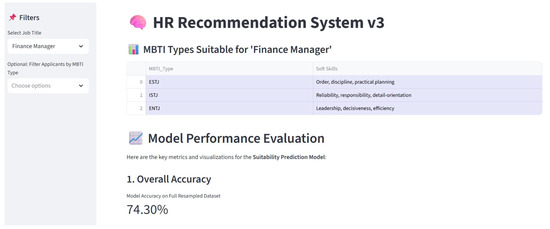
Figure 4.
HR recommendation system dashboard.
The model achieved an overall accuracy of 74.30%, indicating that nearly three quarters of its predictions were correct. This is a strong result for a binary classification task, significantly outperforming random guessing (50%). This suggests that the model successfully learned meaningful patterns from the data to distinguish between suitable and unsuitable candidates.
4.1. Confusion Matrix Analysis
The confusion matrix illustrates the model’s classification performance across both classes. Out of 14,208 samples, 5420 were True Negatives, 1684 were False Negatives, 1838 were False Negatives, and 5266 were True Positives. Details are depicted in Figure 5.
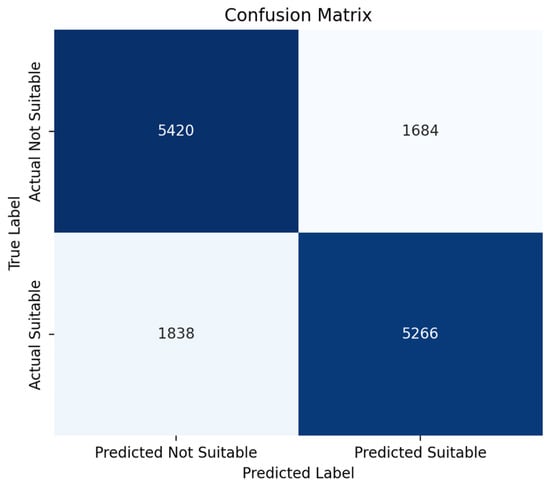
Figure 5.
Confusion matrix.
This relatively balanced distribution of correct and incorrect predictions suggests that the model performed consistently across both classes without significant bias.
4.2. Classification Report
The classification report offers a detailed view of the model’s performance across both classes using precision, recall, and the F1-score. For the “Not Suitable” class (Class 0), the model achieved a precision of 0.74, recall of 0.76, and an F1-score of 0.75. Similarly, for the “Suitable” class (Class 1), the precision was 0.75, recall was 0.74, and the F1-score stood at 0.75. Details are shown in Table 2.

Table 2.
Classification report.
These closely aligned values indicate that the model performed consistently across both categories. Furthermore, the macro and weighted averages for all metrics were equal and above 0.75, suggesting not only balanced model performance but also a relatively even class distribution within the dataset.
4.3. ROC Curve and AUC
The Receiver Operating Characteristic (ROC) curve demonstrates the model’s ability to distinguish between the two classes. The ROC Curve and AUC are depicted in Figure 6. The Area Under the Curve (AUC) is 0.83, which is considered very good. This indicates that the model ranks positive instances (suitable applicants) higher than negative ones with high reliability.
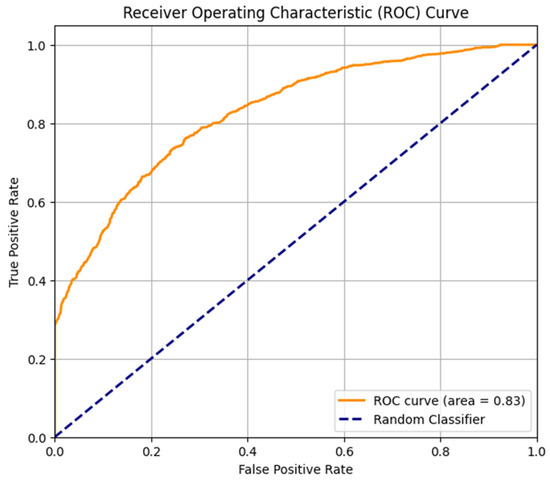
Figure 6.
ROC curve and AUC.
4.4. Precision–Recall Curve and AUC
The precision–recall (PR) curve further validates the model’s performance, especially in scenarios where class imbalance or cost-sensitive errors are critical. The PR AUC of 0.85 is excellent, showing that the model maintains high precision even as recall increases, as depicted in Figure 7.
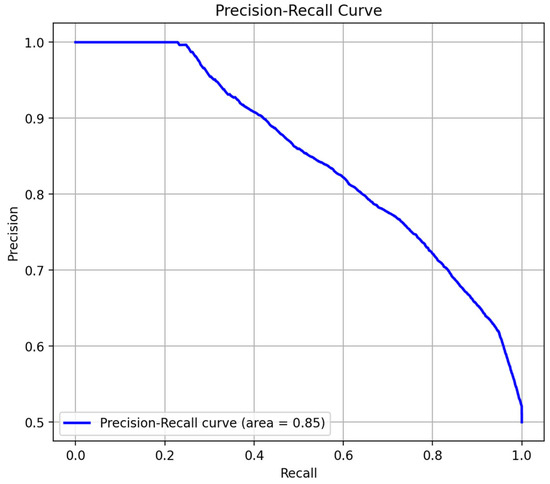
Figure 7.
Precision–recall curve and AUC.
4.5. Overall Feature Importance Using SHAP
The SHAP (Shapley Additive Explanations) summary plot is essential for explaining how a model makes its decisions. It provides a visual summary of the features that have the greatest impact on the model’s predictions. The length of each bar indicates the average magnitude of the feature’s impact on the model’s output across the entire dataset. A longer bar means the feature is, on average, more important for predicting candidate suitability. The figure illustrates the following insights:
- ○
- Based on the plot, the mbti_encoded feature has the highest overall importance. This is a critical finding, as it provides quantitative evidence that the core premise of research—that MBTI personality types are a powerful predictor of job fit—is supported by the model’s behavior.
- ○
- The second most important feature is skill, which aligns with conventional wisdom in recruitment. This confirms that the model also leverages traditional metrics in its decision-making process.
- ○
- Other features, such as experience, is_phd, and is_ms, also contribute to the prediction but to a lesser degree.
Figure 8 provides direct evidence that the model not only predicts suitability effectively but also confirms that personality type is the most influential factor in its decision-making, validating the framework’s central hypothesis.
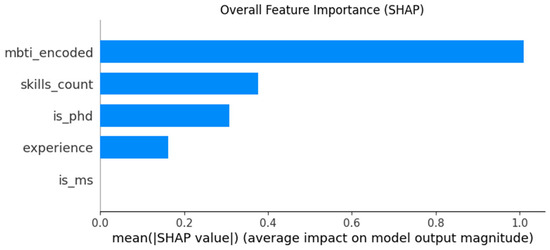
Figure 8.
Overall feature importance (SHAP).
The SHAP (SHapley Additive exPlanations) summary plot is shown in Figure 9, which visualizes the contribution of individual features to the output of the machine learning model used in this study. SHAP values quantify how much each feature influences the model’s prediction, either positively or negatively, relative to the base value.
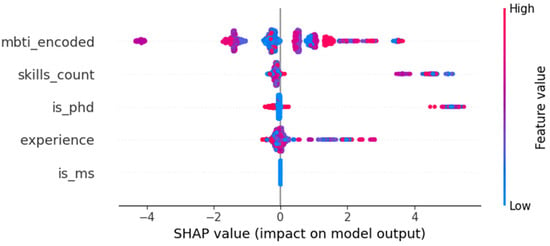
Figure 9.
Waterfall feature value.
- ○
- MBTI Type (mbti_encoded): shows the highest variability in SHAP values, indicating that personality type significantly influences suitability predictions.
- ○
- Skill Count: higher values (red) tend to push predictions positively, suggesting that applicants with more skills are more likely to be deemed suitable.
- ○
- PhD Qualification (is_phd): generally contributes negatively to predictions, possibly due to overqualification or mismatch with job expectations.
- ○
- Experience: has mixed effects, with both high and low values influencing predictions in different directions.
- ○
- Master’s Qualification (is_ms): shows a relatively neutral to slightly positive impact.
This interpretability analysis supports the model’s transparency and helps validate the relevance of selected features in predicting candidate–job fit.
4.6. Use Case: Software Developer Recommendation
To demonstrate the practical application of the suitability prediction model, a targeted search was conducted for the role of Software Developer using the HR recommendation system. Leveraging the model’s robust classification capabilities, validated through metrics such as 74.30% accuracy, balanced precision and recall, and high ROC and PR AUC scores, the system filtered through the applicant pool to identify the most suitable candidates.
To illustrate the system’s functionality and maintain privacy, the names, email addresses, and other personal data presented in Figure 10 and Figure 11 are fabricated and do not correspond to real individuals. Based on the input features, including qualifications, experience, skills, and MBTI indicators, the model generated a ranked list of the top 10 most suitable applicants. This filtered output was presented through an interactive dashboard, as shown in Figure 10, which highlights key applicant attributes and suitability scores. Additionally, the system provided direct access to the CVs of the shortlisted candidates, enabling HR professionals to conduct a more informed and efficient review process, as illustrated in Figure 11.
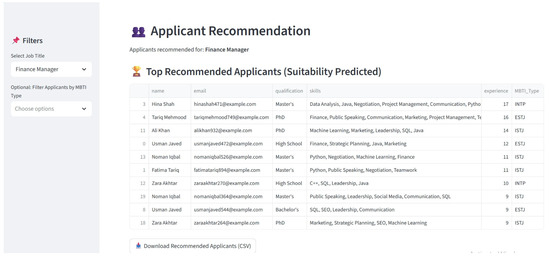
Figure 10.
Applicant recommendations.
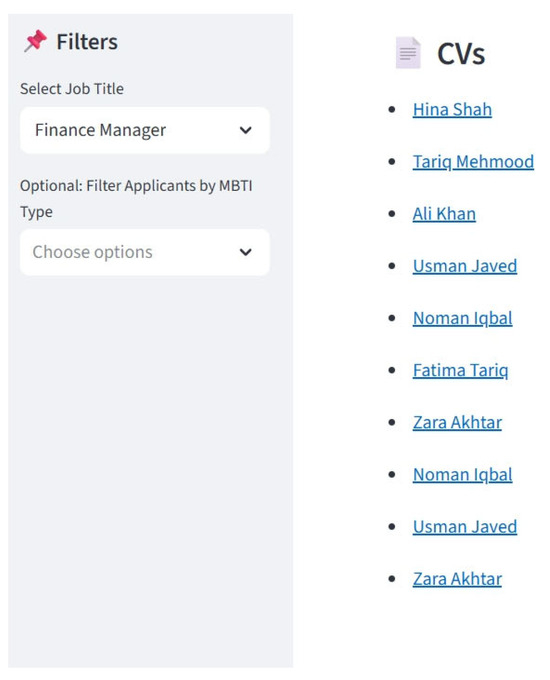
Figure 11.
Selected CV dashboard.
This use case exemplifies the model’s practical value in streamlining recruitment workflows and enhancing decision-making through data-driven insights.
These results represent a marked improvement over previous models that attempted to predict MBTI types directly. The current approach offers a more reliable and practical method for assessing applicant suitability based on the selected features, making it a valuable tool for data-driven decision-making in recruitment contexts.
5. Discussion
The aim of this study was to investigate the possibility of personality profiling through implementation of the MBTI framework into machine learning-based recruiting processes to enhance the recruitment process in companies. The findings strongly indicate that the model is reliable as regards establishing the right candidates. The model exhibits a strong point of distinction between applicants who are probably a good fit and those who are not, with an accuracy of 74.30% and balanced precision and recall scores.
The confusion matrix and the classification report further prove that the model is not biased towards any of the classes, namely, “Suitable” and “Not Suitable”. This is especially important in recruitment, as bias may cause poor recruitment results. The ROC AUC score (0.84) and precision–recall AUC score (0.85) are also high, showing that the model is not just precise but also exhibits confidence in its predictions when working with imbalanced data.
In addition to its technical performance, this solution effectively bridges the gap in current recruitment processes in developing countries, where recruitment is usually an act of subjective decision-making based on limited data. The model facilitates equality and openness during the assessment of candidates by utilizing a structured method and approach based on personality. It applies especially to environments where culture and interpersonal relations constitute the important determinants of success in the workplace. The possibility of psychological understanding of a system within the frame of quantifiable characteristics such as experience and skills provides a much more complex consideration of candidate potential and allows for progress in organizations in terms of more inclusive and evidence-based talent selection approaches.
The scenario of the Software Developer occupation explains how the system may be used in real life. The system allows HR professionals to have a more comprehensive profile of each job candidate due to its filtering and ranking of applicants based on technical specifications and personality fit. This way, not only is time saved but also the quality of hiring decisions is elevated.
6. Conclusions
In this study, a personality-based approach to recruiting has been proposed, used in combination with machine learning to enable evidence-based recruitment. The system manages to automate the process of personality–job fit, overcoming the most crucial limitations of the conventional methods of recruitment, which include subjectivity, inefficiency, and a lack of psychological insight. The high values of the performance indicators of the model, if successfully applied in real practice, indicate the possibility of changing the patterns of organizing the recruitment process, in particular the features of work in areas where the traditional approach remains predominant. With the inclusion of the element of personality testing into the very fabric of the hiring process, the system will provide a more direct and human approach to the evaluation of candidates. In general, this research provides evidence that profiling candidates based on MBTI, with the addition of machine learning, can produce good results when hiring a candidate, not only satisfying job specifications but also matching the candidate with the psychological needs of the position.
7. Future Work and Ethical Considerations
Even though the current system can serve as a good foundation, it can be enhanced in a number of significant ways. The system could be improved in the future by assessing candidate fit into team environments or candidate fit in a company culture—aspects that are not related to a candidate’s qualifications. The system can also be made more adaptable to various hiring goals, but this can be enhanced in terms of flexibility to alter the level of information that can be provided to HR workers. Addressing the lack of transparency associated with the decision-making of the system by using explainable AI would build more trust, and testing it in various cultural locations may contribute to making it a versatile, globally applicable application. Future development efforts should concentrate on adding anonymized real-world data from actual hires from multiple South Asian organizations to supplement the current approach. This would include gathering detailed profiles of successful candidates, including their personality traits, abilities, qualifications, and, critically, post-hire performance measures. By training the model using such a dataset, the framework could be empirically validated against real business outcomes, extending beyond a theoretical proof of concept. This would not only improve the accuracy of the model but make it much more generalizable and applicable across the region.
The development of AI-based recruitment systems—in particular, personality-based systems—requires a short-term, thorough, and theoretical ethical approach. On the one hand, challenges and candidate appraisal are subject to bias; on the other hand, our framework is more of a holistic approach to candidates, and it is necessary to acknowledge the risks of algorithmic bias. When AI models are being trained, they absorb the information they are tasked with working on; as soon as a model is biased by history or society, it can inadvertently strengthen and support the bias. One of the primary risks in a diverse territory such as South Asia is the threat that an algorithm can be unfairly prejudiced when determining personality traits in preference to others. Although the MBTI framework is as helpful as possible, it is also based on a culture of individualism that is predominantly Western. Unless the model is sufficiently reviewed, it will involuntarily concentrate on individualistic characteristics and underplay the collectivist characteristics that are highly valued in most South Asian cultures. This may lead to systemic elimination of well-qualified candidates on the premise of cultural and not professional misfit.
In order to mitigate these risks and make the framework responsible and fair, we propose two future critical safeguards. The model should have regular and systematic fairness audits to assess its predictions for potential disparate impact across different demographic groups. This is important to ensure that recommendations are not biased by things such as age, gender, or cultural background. Most of all, it is vitally important that this system operates as a decision support tool instead of an autonomous decision-maker. We strongly suggest that human supervision must be a required part of the recruitment process. The recommendations of the model should be one data point among many, to enable human recruiters to use contextual understanding and empathy to stop the perpetuation of algorithmic bias. This “human-in-the-loop” approach provides a means of accountability and retains the necessary human element in a sensitive process such as hiring.
Author Contributions
Conceptualization, M.U.S. and S.N.; methodology, M.U.S. and M.I.A.; software, S.N. and M.I.A.; validation, H.W.K. and S.N.; formal analysis, M.U.S. and S.N.; investigation, H.W.K. and M.I.A.; resources, M.I.A. and S.N.; data curation, M.U.S. and H.W.K.; writing—original draft preparation, M.U.S. and S.N.; writing—review and editing, H.W.K., S.N. and M.I.A.; visualization, M.I.A. and H.W.K.; supervision, M.U.S.; project administration, M.U.S. and S.N. All authors have read and agreed to the published version of the manuscript.
Funding
This research received no external funding.
Institutional Review Board Statement
The study was conducted in accordance with the Declaration of Helsinki, and approved by the Ethics Committee of Namal University Mianwali (Ref. No.: NUM/BS/DCOPE/Y25/16. Dated: 5 June 2025).
Informed Consent Statement
Informed consent was obtained from all participants prior to the commencement of this study.
Data Availability Statement
The dataset used in this study is available on request.
Acknowledgments
The authors would like to acknowledge the use of ChatGPT-4 24 May 2023 version (OpenAI, San Francisco, CA, USA), specifically to assist in some content rewriting for improved clarity and effectiveness.
Conflicts of Interest
The authors declare no conflicts of interest.
Abbreviations
The following abbreviations are used in this manuscript:
| MBTI | Myers–Briggs Type Indicator |
| ROC | Receiver Operating Characteristic |
| NLP | Natural Language Processing |
| RF | Random Forest |
| AI | Artificial Intelligence |
| TPs | True Positives |
| TNs | True Negatives |
| FPs | False Positives |
| FNs | False Negatives |
References
- Shahzad, M.A.; Jianguo, D.; Junaid, M. Impact of green HRM practices on sustainable performance: Mediating role of green innovation, green culture, green employees’ behavior. Environ. Sci. Pollut. Res. 2023, 30, 88524–88547. [Google Scholar] [CrossRef]
- Shah, A.; Pati, R.; Pimplikar, A.; Puthran, S.; Singh, A. Review of Approaches Towards Building AI Based Career Recommender & Guidance Systems. ScienceOpen 2024. preprints. [Google Scholar] [CrossRef]
- Choubey, A.P.; Agrawal, A.K. Recruit to rise and retain: The CORE–2π framework for successful and sustainable talent acquisition. Organ. Dyn. 2025, 54, 101160. [Google Scholar] [CrossRef]
- Ling, F.Y.Y.; Sim, W.X.L. Mediating Role of Vocational Interest in the Relationship between Personality and Job Satisfaction: Insights from Cost Engineers. J. Constr. Eng. Manag. 2025, 151, 04025057. [Google Scholar] [CrossRef]
- Mohammad, A.J. Chrono-Behavioral Fingerprinting for Workforce Optimization. Int. J. AI BigData Comput. Manag. Stud. 2024, 5, 91–101. [Google Scholar] [CrossRef]
- Nirmala, M.; Rajalakshmi, B.; Sarvepally, S.R.M.; Mandava, S.; Megana, M. Personality Detection for Recruitment Using Machine Learning. In Proceedings of the 6th International Conference on Communications and Cyber Physical Engineering, Hyderabad, India, 28–29 April 2023; Kumar, A., Mozar, S., Eds.; Lecture Notes in Electrical Engineering Series; Springer: Singapore, 2024; Volume 1096, pp. 399–406. [Google Scholar] [CrossRef]
- Naz, A.; Khan, H.U.; Bukhari, A.; Alshemaimri, B.; Daud, A.; Ramzan, M. Machine and deep learning for personality traits detection: A comprehensive survey and open research challenges. Artif. Intell. Rev. 2025, 58, 239. [Google Scholar] [CrossRef]
- Anusha, M.; Yoshitha, C.R.; Namratha, D.S.; Manoj, B.S.; Kausalya Nandan, T.P.; Raju, P.S. Text-Based Personality Assessment Using Deep Learning Techniques. In Proceedings of the International Conference on Emerging Technologies in Computer Science for Interdisciplinary Applications (ICETCS 2024), Bengaluru, India, 22–23 April 2024. [Google Scholar] [CrossRef]
- Sergi, M.R.; Picconi, L.; Aleffi, C.; Tommasi, M.; Lee, H.; Shin, Y. A Study on MBTI Perceptions in South Korea: Big Data Analysis from the Perspective of Applying MBTI to Contribute to the Sustainable Growth of Communities. Sustainability 2024, 16, 4152. [Google Scholar] [CrossRef]
- Park, J.S.Y. Personality as technology of self: MBTI and English language learning in South Korea. Int. J. Soc. Lang. 2024, 285, 35–54. [Google Scholar] [CrossRef]
- Agarwal, N.; Justina; Akshaya, M.J.; Shetty, N.; Kumar, S. Machine Learning Driven Personality Prediction System using the concept of CV Analysis. In Proceedings of the 2024 International Conference on Electrical Electronics and Computing Technologies (ICEECT), Greater Noida, India, 29–31 August 2024; pp. 1–6. [Google Scholar] [CrossRef]
- Tursunbayeva, A. Augmenting Human Resource Management with Artificial Intelligence: Towards an Inclusive, Sustainable, Responsible Future; Contributions to Management Science Series; Part F3983; Springer: Cham, Switzerland, 2024; pp. 1–148. [Google Scholar] [CrossRef]
- Pramanik, N.; Das, P.; Roy, R.; Bal, S. Job Recommendation System Based on Candidate Skills. In Proceedings of the 2024 3rd International Conference on Smart Technologies and Systems for Next Generation Computing (ICSTSN), Villupuram, India, 18–19 July 2024. [Google Scholar] [CrossRef]
- Yuan, C.; Hong, Y.; Wu, J. Who Are You Meant to Be? Predicting Psychological Indicators and Occupations based on Personality Traits. J. Syst. Sci. Syst. Eng. 2023, 32, 571–602. [Google Scholar] [CrossRef]
- Sirasapalli, J.J.; Malla, R.M. A deep learning approach to text-based personality prediction using multiple data sources mapping. Neural Comput. Appl. 2023, 35, 20619–20630. [Google Scholar] [CrossRef]
- Shaheen, N.; Hussain, A.; Ahmad, N.; Jan, A.S.; Khan, N.U. The Entrepreneurial Mindset: Leveraging MBTI to Identify and Nurture Entrepreneurial Potential. Dialogue Social Sci. Rev. 2025, 3, 433–443. Available online: https://dialoguessr.com/index.php/2/article/view/625 (accessed on 26 July 2025).
- Cambria, E. Pragmatics Processing. In Understanding Natural Language Understanding; Springer: Cham, Switzerland, 2025; pp. 229–338. [Google Scholar] [CrossRef]
- Perera, H.; Costa, L. MBTI Personality Classification through Analyzing CVs/Personal Statements for e-Recruitment. Int. J. Mach. Learn. 2024, 14, 1153. [Google Scholar] [CrossRef]
- Bousalem, S.; Benchikha, F.; Marir, N. Personalized Learning Through MBTI Prediction: A Deep Learning Approach Integrated with Learner Profile Ontology. IEEE Access 2025, 13, 30861–30873. [Google Scholar] [CrossRef]
- An, B.; Park, J.; Shin, D.; Kim, H.L.; Lee, H. Measuring Organizational Character: Leveraging Sentence-BERT and MBTI. SSRN 2024. [Google Scholar] [CrossRef]
- Troyer, K.; Jackson, R.; Wilson, R.; Besson, L. Introducing Personality Psychology in Business: Insights & Implications from a Textual Analysis. Open J. Bus. Manag. 2024, 12, 1845–1871. [Google Scholar] [CrossRef]
- Erford, B.T.; Zhang, X.; Sweeting, E.L.; Russo, M.; Rashid, A.; Sherman, M.F.; Bradford, E.L.; Wang, X.; Gao, A.; Huang, X.; et al. A 25-Year Review and Psychometric Synthesis of the Myers–Briggs Type Indicator (MBTI)—Form M. J. Couns. Dev. 2025, 103, 403–417. [Google Scholar] [CrossRef]
- Elmahalawy, A.R.; Li, L.; Wu, X.; Tao, X.; Yong, J. Computational Personality Analysis with Interpretability Empowered Prediction. In Proceedings of the 2024 27th International Conference on Computer Supported Cooperative Work in Design (CSCWD), Tianjin, China, 8–10 May 2024. [Google Scholar]
- Braz, L.F.; Sichman, J.S. Using the Myers-Briggs Type Indicator (MBTI) for Modeling Multiagent Systems. Rev. Inform. Teórica Apl. 2022, 29, 42–53. [Google Scholar] [CrossRef]
- Albassam, W.A.A. The Power of Artificial Intelligence in Recruitment: An Analytical Review of Current AI-Based Recruitment Strategies. Int. J. Prof. Bus. Rev. 2023, 8, e02089. [Google Scholar] [CrossRef]
- Pradhan, A.; Year, M.; Moser, R. Employee–Job Profile Matching Challenges: AI/ML-Based Recommender Systems Solutions for Knowledge Workers. Master’s Thesis, Macquarie University, Macquarie Park, NSW, Australia, March 2024. [Google Scholar] [CrossRef]
- Ajjam, M.-H.; Al-Raweshidy, H. AI-Driven Semantic Similarity-Based Job Matching Framework for Recruitment Systems. Inf. Sci. 2025, 724, 122728. [Google Scholar] [CrossRef]
- Goo, C.L.; Leow, M.C.; Ong, L.Y. Analyzing Course Selection by MBTI Personality Types. JOIV Int. J. Inform. Vis. 2025, 9, 29–37. [Google Scholar] [CrossRef]
- Kamble, P.; Kulkarni, U. An Innovative Approach of Personality Recognition for E-Recruitment. In Proceedings of the 2022 5th International Conference on Advances in Science and Technology (ICAST), Mumbai, India, 2–3 December 2022; pp. 324–328. [Google Scholar] [CrossRef]
- Haldar, S. The future of work: A symbiotic balance of technology and interpersonal skills. Strateg. HR Rev. 2024, 23, 217–220. [Google Scholar] [CrossRef]
- Thapa, L.; Pandey, A.; Gupta, D.; Deep, A.; Garg, R. A Framework for Personality Prediction for E-Recruitment Using Machine Learning Algorithms. In Proceedings of the 14th International Conference on Cloud Computing, Data Science and Engineering, Confluence 2024, Noida, India, 18–19 January 2024; pp. 1–5. [Google Scholar] [CrossRef]
- Akshaya, J.; Sharma, A.; Rathod, Y.; Sridhar, S. Real time personality assessment via Big Five Traits. Res. Sq. 2025. [Google Scholar] [CrossRef]
- Sudha, G.; Sasipriya, K.K.; Nivethitha, D.; Saranya, S. Personality Prediction Through CV Analysis using Machine Learning Algorithms for Automated E-Recruitment Process. In Proceedings of the 2021 4th International Conference on Computing and Communications Technologies (ICCCT), Chennai, India, 16–17 December 2021; pp. 617–622. [Google Scholar] [CrossRef]
Disclaimer/Publisher’s Note: The statements, opinions and data contained in all publications are solely those of the individual author(s) and contributor(s) and not of MDPI and/or the editor(s). MDPI and/or the editor(s) disclaim responsibility for any injury to people or property resulting from any ideas, methods, instructions or products referred to in the content. |
© 2025 by the authors. Licensee MDPI, Basel, Switzerland. This article is an open access article distributed under the terms and conditions of the Creative Commons Attribution (CC BY) license (https://creativecommons.org/licenses/by/4.0/).